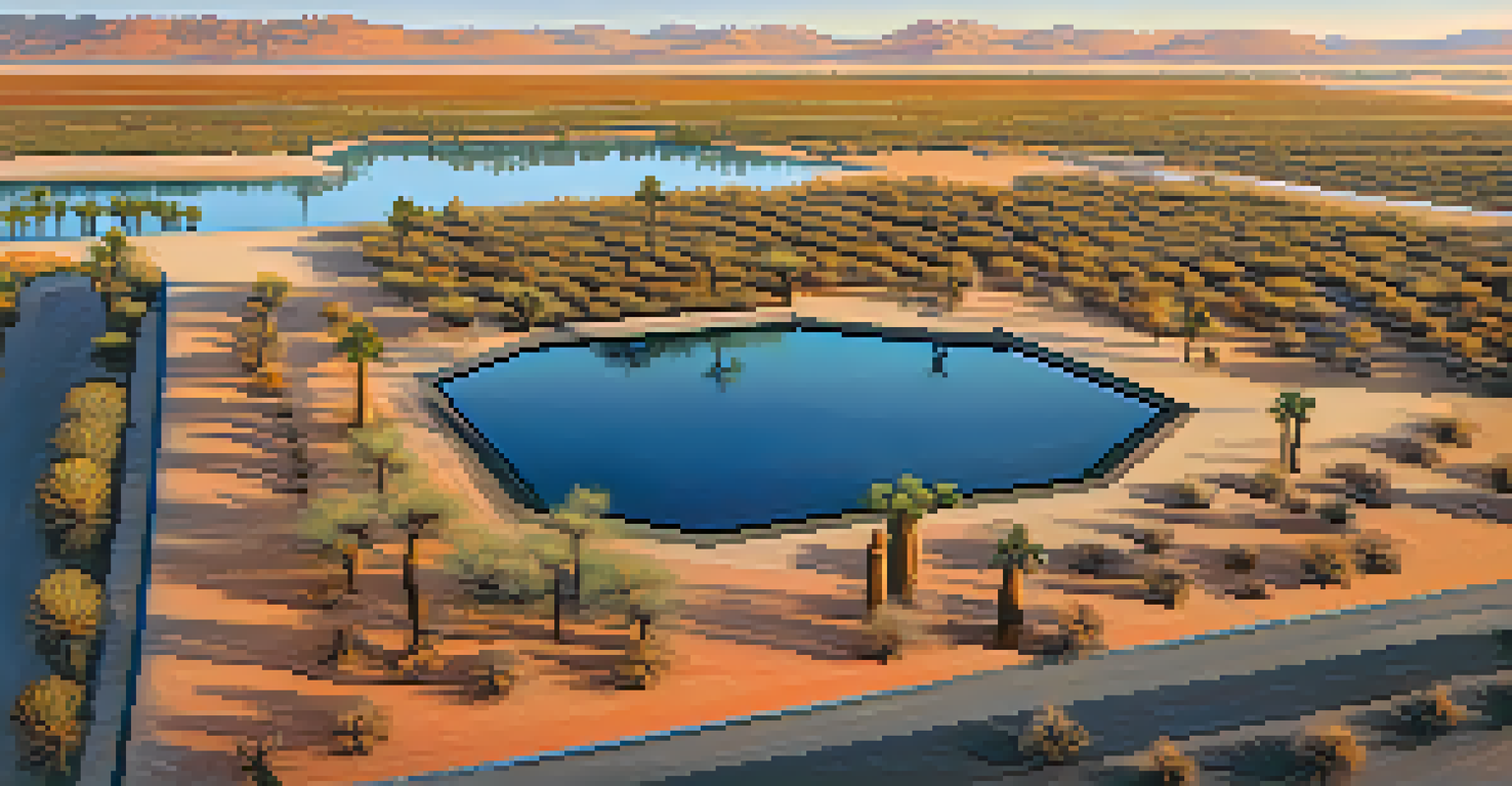Groundwater Recharge: Methods to Sustain Arizona's Aquifers

Understanding Arizona's Groundwater Challenges
Arizona faces significant challenges regarding groundwater resources, largely due to its arid climate. With limited rainfall and high evaporation rates, the state heavily relies on its aquifers to meet water needs. Over-extraction for agricultural, industrial, and residential use has led to a worrying decline in groundwater levels. This situation underscores the urgent need for effective groundwater recharge methods to ensure sustainability.
Water is the driving force of all nature.
The depletion of aquifers not only threatens water supply but also impacts local ecosystems. As water tables drop, vegetation suffers, and wildlife habitats can be compromised, leading to broader ecological issues. Moreover, land subsidence can occur when aquifers are overdrawn, causing infrastructure challenges. Consequently, understanding and implementing recharge methods becomes essential for both humans and nature.
In light of these challenges, it's crucial to explore innovative and sustainable methods to recharge Arizona's aquifers. By focusing on effective recharge strategies, we can help stabilize groundwater levels and ensure a reliable water supply for future generations.
The Benefits of Groundwater Recharge
Groundwater recharge offers numerous benefits, not only for water conservation but also for enhancing environmental health. By replenishing aquifers, we can maintain a stable water supply for agricultural and urban use, which is particularly vital in arid regions like Arizona. Furthermore, recharged aquifers can help mitigate the effects of drought, providing a buffer during dry spells.

Recharge methods also support local ecosystems by preserving wetlands and maintaining groundwater-dependent habitats. Healthy aquifers contribute to the overall health of rivers and streams, ensuring that aquatic life thrives. This interconnectedness highlights the importance of viewing groundwater management as part of a larger environmental strategy.
Groundwater Depletion Threatens Arizona
Arizona's aquifers are declining due to over-extraction, highlighting the urgent need for sustainable recharge methods.
Finally, investing in groundwater recharge can yield economic benefits by reducing reliance on expensive water imports. Sustainable water management practices can lead to lower water costs for residents and businesses alike, supporting the state’s economy. Thus, the benefits of groundwater recharge extend far beyond mere water supply; they contribute to ecological and economic resilience.
Natural Recharge Methods: Harnessing Nature's Power
Natural recharge methods involve utilizing the earth's natural processes to replenish groundwater. One effective technique is the use of infiltration basins, which are shallow depressions designed to capture rainwater and allow it to seep into the ground. This method mimics the natural absorption of rain, helping to restore aquifer levels efficiently.
The greatest threat to our planet is the belief that someone else will save it.
Additionally, preserving natural landscapes such as forests and wetlands plays a crucial role in groundwater recharge. These ecosystems naturally filter and store water, promoting a healthy water cycle. By protecting these areas, we not only enhance groundwater recharge but also support biodiversity and climate resilience.
Another approach is to implement sustainable agricultural practices, such as cover cropping and reduced tillage, which improve soil health and enhance water retention. These practices can significantly increase the amount of rainwater that infiltrates the ground, contributing to aquifer recharge. By working with nature, we can create a more sustainable water management system.
Artificial Recharge Techniques: Engineering Solutions
Artificial recharge techniques involve human intervention to enhance groundwater levels. One common method is the construction of recharge wells, which allow surface water to be directly injected into aquifers. This technique helps to quickly replenish groundwater supplies, especially in areas experiencing severe depletion.
Another effective artificial method is the use of recharge ponds, where surface water is stored temporarily to promote infiltration. These ponds can capture stormwater runoff, allowing it to percolate into the ground over time. This not only helps recharge aquifers but also reduces flooding and erosion.
Recharge Methods Enhance Ecosystems
Both natural and artificial recharge techniques play a crucial role in maintaining local ecosystems and ensuring water supply.
Furthermore, managed aquifer recharge (MAR) systems combine both natural and artificial methods, providing flexibility in how water is introduced to aquifers. By carefully managing the timing and quantity of water injected, these systems can optimize recharge rates and improve water quality. Such innovative engineering solutions are vital for addressing Arizona's groundwater challenges.
Community Involvement in Groundwater Recharge Efforts
Community involvement is essential in promoting effective groundwater recharge initiatives across Arizona. Local residents can play a crucial role by participating in and supporting conservation projects, such as rainwater harvesting systems. These systems collect and store rainwater for future use, reducing reliance on groundwater and encouraging sustainable practices.
Educational programs can also empower communities to understand the importance of groundwater recharge. By raising awareness about water conservation and encouraging responsible water use, communities can work together to protect this vital resource. Workshops and informational campaigns can engage residents in practical solutions that benefit both their households and the environment.
Moreover, collaborative efforts between local governments, businesses, and residents can lead to more significant impacts. By forming partnerships to implement recharge projects, communities can pool resources and expertise, maximize efficiency, and foster a shared commitment to sustainable water management. Together, collective action can create a more resilient future for Arizona's aquifers.
Policy and Regulation: Supporting Groundwater Recharge
Effective policy and regulation play a crucial role in promoting groundwater recharge efforts in Arizona. Government agencies can implement policies that encourage sustainable water use and protect recharge areas from development. By establishing regulations that limit groundwater extraction, authorities can help maintain a balance between water supply and demand.
Incentives for landowners to adopt recharge practices can also be effective in promoting community-wide participation. Financial assistance or tax breaks for projects that enhance groundwater recharge can motivate individuals and businesses to invest in sustainable water management. Such policies can create a culture of conservation while contributing to the overall health of aquifers.
Community Involvement is Key
Engaging local communities in groundwater recharge initiatives fosters sustainable practices and collective action for water conservation.
Furthermore, collaboration between state and local governments is essential for effective groundwater management. By sharing data and resources, agencies can develop comprehensive strategies that address both immediate needs and long-term sustainability. Strong governance frameworks can ensure that groundwater recharge efforts are supported and maintained over time.
The Future of Groundwater Recharge in Arizona
Looking ahead, the future of groundwater recharge in Arizona depends on a combination of innovative methods, community engagement, and effective policy. As climate change continues to impact water availability, prioritizing sustainable recharge practices will be critical. Investing in research and technology can help identify new strategies and improve existing methods for replenishing aquifers.
Collaboration among stakeholders, including government, private sector, and communities, will be vital to fostering a shared vision for water sustainability. By working together, we can create resilient systems that support both current and future generations. This collective effort can lead to a more sustainable balance between water demand and supply.

Ultimately, a commitment to groundwater recharge not only secures water for Arizona but also protects the state's unique ecosystems and communities. By embracing innovative solutions and fostering a culture of conservation, we can ensure that Arizona's aquifers remain healthy and sustainable for years to come.